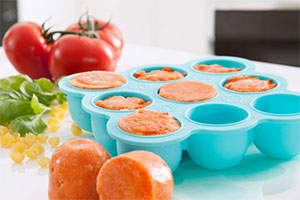Home cooked meals for infants not always better than shop bought ones
Usually a lot cheaper, but energy density and total fat content too high
 Home cooked meals specifically designed for infants and young children, are not always better than commercially available baby foods.
Home cooked meals specifically designed for infants and young children, are not always better than commercially available baby foods.
That’s suggested by research by the University of Warwick and the University of Aberdeen published online in the Archives of Disease in Childhood.
Often perceived as the best option, home cooked meals are usually cheaper—unless organic ingredients are used—but they usually exceed energy density and dietary fat recommendations, the findings indicate.
It’s recommended that the introduction of solid foods, known as weaning, begins when a child is six months old. It should include a variety of foods to provide a balanced diet rich in a broad range of nutrients.
The researchers wanted to assess how well homemade and commercially available readymade meals designed for infants and young children met age specific national dietary recommendations.
They therefore compared the nutrient content, price, and food group variety of 278 readymade savoury meals, 174 of which were organic, and 408 home cooked meals, made using recipes from 55 bestselling cookbooks designed for the diets of infants and young children.
The pre-prepared meals were all available from major UK supermarkets, a leading pharmacy chain, and a major health and beauty chain.
In terms of the food group content, 16% of the home cooked meals were poultry based compared with 27% of the readymade meals; around one in five (19%) were seafood based vs 7% of the readymade meals; a similar proportion (21%) were meat based compared with 35% of the commercial products; and almost half (44%) were vegetable based compared with around a third (31%) of the readymade meals.
Home cooked meals included a greater variety of vegetables (33%) than readymade meals (22%), but commercial products contained a greater vegetable variety per meal, averaging three compared with two for home cooked recipes.
Home cooked meals also provided 26% more energy and 44% more protein and total fat, including saturated fat, than commercial products.
And while almost two thirds (65%) of commercial products met dietary recommendations on energy density, only just over a third of home cooked meals did so, and over half (52%) exceeded the maximum range.
But home cooked meals were around half the price of commercially available readymade meals: £0.33/100 g compared with £0.68/100 g, excluding fuel costs.
One of the researchers Dr Debbi Marais, Principal Teaching Fellow at Warwick Medical School, University of Warwick said: “Unlike adult recommendations, which encourage reducing energy density and fats, it is important in infants that food is suitably energy dense in appropriately sized meals to aid growth and development.”
Sharon Carstairs, of the Health Services Research Unit, School of Medicine and Dentistry, University of Aberdeen and lead author added: “Dietary fats contribute essential fatty acids and fat soluble vitamins together with energy and sensory qualities, thus are vital for the growing child, however excessive intakes may impact on childhood obesity and health.”
The researchers highlight that the lower protein content of readymade meals might be due to the higher proportion of early stage meals on the market while predominantly vegetable based meals are recommended for first tastes.
Furthermore, parents may choose to vary the content of recipes, and there are likely to be natural variations in the nutritional content of raw ingredients, thus making direct comparisons harder to make.
Ready meals are a convenient alternative, they say, but suggest that any parent looking to provide their child with a varied diet, should probably not rely solely on this source.
However, they state that the high proportion of red meat-based meals and recipes and low seafood meals are of concern when dietary recommendations encourage an increase in oil-rich fish consumption and limitation of red and processed meats.
Source: University of Warwick
Full bibliographic information:
Research: A comparison of preprepared commercial infant feeding meals with home cooked recipes
Journal: Archives of Disease in Childhood


